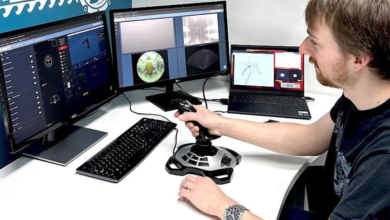Italy’s military mulling space-based supercomputing cloud • The Register

Italy’s Ministry of Defense is exploring a “military space cloud” and has commissioned state-backed aerospace contractor Leonardo to test the concept.
The Military Space Cloud Architecture project “intends to define a space-based architecture capable of providing government and national armed forces with high-performance computing and storage capacity directly in space,” Leonardo explained on Monday.
The plan calls for a constellation of satellites, each capable of 250 teraFLOPS at single precision performance and storing at least 100TB in orbit.
To put that in perspective, Nvidia’s H100 SXM, currently its flagship GPU, is capable of 989 teraFLOPS of sparse single precision performance when using the TensorFloat-32 data type. Meanwhile, storage requirements could be achieved using a handful of high-capacity NVMe drives, like the 61.44TB Solidigm ones our sibling site Blocks and Files looked at last year.
These resources would be networked together to support artificial intelligence workloads and data analysis in what would essentially be an orbital supercomputing cluster. Leonardo claims the constellation would allow data to be processed faster, with higher availability for those on the ground, and make its communications less vulnerable to interruption than with a terrestrial system.
“A cyber-secure supercomputer and archive system in space will guarantee users access to strategic data such as communication, earth observation, and navigational data anywhere, even in the most remote places and at any time,” Leonardo explained. “Storing data in orbit will also represent a useful backup of Earth centers, which are most exposed to natural disasters.”
Or that’s the idea anyway. Leonardo, alongside its joint ventures Telespazio and Thales Alenia Space, will study the concept over the next two years to determine whether space-based supercomputers will ever get off the ground.
The study will take place in two phases. The first seeks to define the architecture on which the satellites would be based while the second will attempt to simulate the deployment of these satellites using a digital twin running on Leonardo’s Davinci-1 supercomputer. The simulation will help to identify potential problems with orbital tracks and estimating coverage areas for communications.
As we’ve previously discussed, space isn’t the most forgiving environment for electronics and requires special considerations such as radiation hardening and high-degrees of redundancy to handle cosmic rays damaging the hardware or corrupting data. There’s also the matter of power, thermal management, and weight that have to be taken into consideration.
While reusable rockets, like those developed by SpaceX, have driven down the cost per kilogram, getting stuff into orbit still ain’t exactly cheap. But, if everything goes well, an experimental phase, if approved, would see a small constellation of satellites launched to conduct real-world testing.
“We will be the first in Europe to develop a space cloud project demonstrating the feasibility and benefits derived from the use of an architecture of this time and enabling a new paradigm of cloud and edge computing,” Leonardo CIO Simone Ungaro said in a canned statement.
This isn’t the first time that Leonardo has been tasked with evaluating space-based compute. Back in 2022, Thales Alenia Space, a joint venture between Leonardo and French conglomerate Thales, was commissioned to conduct a feasibility study on launching datacenters into orbit as part of the Horizon Europe research program. However, in that case the goal of the motivation was environmental.
More recently, Axiom Space revealed it would build and launch an orbital datacenter to support missions aboard its commercial space station. In that case, the goal was to reduce reliance on terrestrial services. ®



